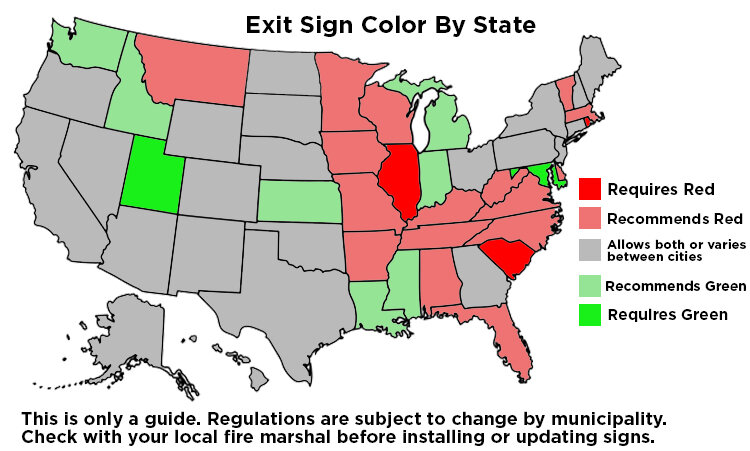
Have you ever wondered why exit signs are always green? It’s not just a random choice; the color green plays a crucial role in ensuring safety during emergencies. Exit signs are designed to be highly visible and easily identifiable, guiding people to safety quickly and efficiently when every second counts. This article will delve into the reasons behind the use of green for exit signs, exploring the science behind its effectiveness and its importance in emergency situations.
This article will examine the specific properties of green light that make it ideal for exit signs, discuss its visibility in various emergency scenarios, and highlight the overall importance of these signs in ensuring public safety.
Exit Sign Color
The color green has been specifically chosen for exit signs due to its unique characteristics and its impact on human perception. Green light possesses a longer wavelength compared to other colors in the visible spectrum. This longer wavelength allows it to penetrate through smoke, haze, and other obscuring elements more effectively.
Furthermore, the human eye is naturally more sensitive to green light than to other colors, particularly in low-light conditions. This heightened sensitivity makes green an excellent choice for signaling pathways and exits, ensuring that people can easily locate them even in dimly lit or smoky environments.
Green Light Visibility

The visibility of green light in various emergency situations is a key factor in its effectiveness as an exit sign color. In fires, for instance, smoke often fills the air, reducing visibility and creating disorientation. Green light, with its longer wavelength, can penetrate through smoke more effectively than other colors, allowing people to see exit signs even when visibility is severely limited.
Similarly, in low-light conditions, such as during a power outage, green light stands out more prominently against the surrounding darkness. This enhanced visibility helps people quickly identify exit routes and navigate safely to safety.
Green Light and the Human Eye
The human eye has a higher concentration of photoreceptor cells called cones that are sensitive to green light compared to other colors. This means that our eyes are naturally better at detecting and processing green wavelengths, making it a more intuitive and recognizable color for signaling and guidance.
This biological advantage further reinforces the effectiveness of green as an exit sign color, ensuring that people can quickly and easily perceive the signs even in challenging visual environments.
Emergency Situations
Exit signs are crucial in a wide range of emergency situations, including fires, natural disasters, and medical emergencies. In these situations, panic and confusion can easily set in, making it difficult for people to think clearly and make rational decisions.
Exit signs provide a clear and unambiguous visual cue, guiding people to safety and reducing the risk of injury or death.
Fires
Fires are a common emergency scenario where exit signs play a vital role. Smoke and flames can quickly engulf a building, creating a hazardous environment with limited visibility. Green exit signs, with their ability to penetrate smoke and their high visibility in low-light conditions, become essential for guiding people to safety.
Natural Disasters
Natural disasters such as earthquakes, hurricanes, and floods can also create chaotic and dangerous situations. Exit signs can help people evacuate buildings and find safe shelter during these events.
Medical Emergencies
In medical emergencies, such as heart attacks or strokes, time is of the essence. Exit signs can help people quickly locate exits and access medical assistance.
Safety in Emergencies

The safety of individuals in emergency situations is paramount. Exit signs contribute significantly to this safety by providing a clear and reliable means of navigation.
Their consistent color, high visibility, and strategic placement ensure that people can quickly and easily identify escape routes, reducing the risk of accidents, injuries, and panic.
Reducing Panic
In emergency situations, panic can lead to irrational behavior and hinder escape efforts. Exit signs provide a sense of order and direction, helping people to remain calm and make rational decisions.
Clear Navigation
Exit signs eliminate confusion and ambiguity, guiding people along designated escape routes. This clear navigation reduces the likelihood of people getting lost or taking unsafe paths.
Time Efficiency
In emergencies, every second counts. Exit signs allow people to quickly locate exits and evacuate buildings efficiently, minimizing exposure to danger.
Conclusion
The use of green for exit signs is a carefully considered decision based on scientific principles and a deep understanding of human perception. Green light’s ability to penetrate smoke, its high visibility in low-light conditions, and the human eye’s natural sensitivity to green wavelengths make it the ideal color for ensuring safety and guiding people to safety during emergencies. Exit signs are an essential component of emergency preparedness, providing a clear and reliable means of navigation that can save lives.
